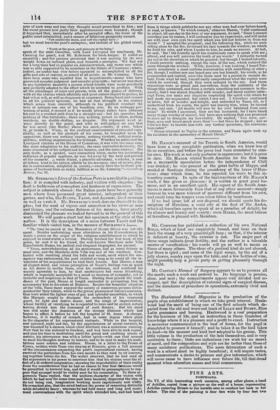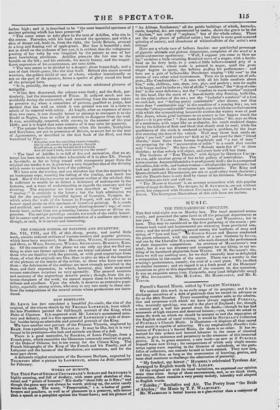FINE ARTS.
POMPEIANA.
No. VI. of this interesting work contains, among other plates, a head of Achilles, copied from a picture on the wall of a house, representing Achilles restoring Briseis to the heralds sent to conduct her back to her father. The size of the painting is four feet wide by four feet two inches high ; and it is :described to be "the most beautiful specimen of ancient painting whic% has been preserved." • " The scene seems to take place in the tent of Achilles, who sits in the centre. Patroclus, with his back toward the spectator, and with a skin of deeper red, leads in, from the right, the lovely Briseis, arrayed in a long and floating veil of apple-green. Her face is beautiful ; and, not to dwell on the archness of her eye, it is evident that the voluptuous pouting of her ruby lip was imagined by the painter as one of her most bewitching attributes. Achilles presents the fair one to the heralds on the left ; and his attitude, his manly beauty, and the magni- ficent expression of his countenance, are inimaable.
"The tent seems to be divided by a drapery about breast-high, and a sort of dark bluish-green like the tent itself. Behind this atand several warriors, the golden shield of one of whom, whether intentionally or not on the part of the painter, forms a species of glory round the head of the principal hero.
"It is, probably, the copy of one of the most celebrated pictures of antiquity. "When first discovered, the colours were fresh ; and the flesh, par. ticularly, had the transparency of Titian. It suffered much and un- avoidably during the excavation, and something from the means taken to preserve it ; when a committee of persons, qualified to judge, had decided that the wall on which it was painted was not in a state to admit of its removal with safety. At length, after an exposure of more than two years, it was thought better to attempt to transport it to the Studii at Naples, than to suffer it entirely to disappear from the wall. It was, accordingly, removed, with success, in the summer of the year 1826; and it is hoped that some remains of it may exist for posterity. "The painter has chosen the moment when the heralds, Talthybius and Eurybates, are put in possession of Briseis to escort her to the tent of Agamemnon, as described in the first boa of the Riad, and thus translated by Pope :—
4 Patroclus now the unwilling beauty brought;
She in soft sorrows and in pensive thought Pass'd silent, as the heralds held her hand,
And oft look'd back, slow moving o'er the strand.'
" The head of Achilles is so full of fire and animation, that an at- tempt has been made to introduce a fac-simile of it in plate XL. Though a fac-simile, as far as being traced with transparent paper from the original can render it so, it gives but a very imperfect idea of the divinity which seems to animate the hero of the painting."
We have seen the tracing, and can therefore say that the engraving is an inadequate copy, wanting the feeling of the tracing, and much too hard. But if the tracing convey an accurate outline of the original, this is sufficient to enable us to detect a deficiency of making-out in the features, and a want of understanding as regards the anatomy and the drawing. The expression we have seen described as "fine " and " staring :" it certainly is the latter ; but the high admiration we feel for the exquisitely beautiful figures of Centaurs, Nymphs, &c. which adorn the walls of the houses in Pompeii, will not allow us to bestow equal praise on this specimen of historical painting. It is crude and artificial, and resembles a country drawing-master's copy of some heroic head, rather than one possessing human character or divine ex- pression. The antique paintings contain. too much of the really beauti- ful in nature and art, to require commendation of a mediocre specimen ; though, as such, it is curious and interesting.



























 Previous page
Previous page